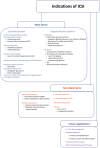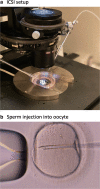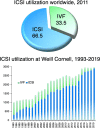Thoughts on the popularity of ICSI
- PMID: 33155089
- PMCID: PMC7823003
- DOI: 10.1007/s10815-020-01987-0
Thoughts on the popularity of ICSI
Abstract
Purpose: Intracytoplasmic sperm injection (ICSI) is the most widely utilized assisted reproductive technique (ART) worldwide. In this feature, we review the early assisted fertilization attempts that eventually led to the development of ICSI, and discuss its current utilization in cases of male and non-male factor infertility.
Methods: We researched the literature related to the development, indications, and current use of ICSI, such as sperm structural abnormalities, male genetic indications, surgically retrieved sperm, high sperm chromatin fragmentation, oocyte dysmorphism, and preimplantation genetic testing (PGT). We also describe the potential future applications of ICSI.
Results: This review summarizes the early micromanipulation techniques that led to the inception of ICSI. We also explore its current indications, including non-male factor infertility, where its use is more controversial. Finally, we consider the benefits of future advancements in reproductive biology that may incorporate ICSI, such as in vitro spermatogenesis, neogametogenesis, and heritable genome editing.
Conclusion: The versatility, consistency, and reliability of ICSI have made it the most prevalently utilized ART procedure worldwide.
Keywords: ART; Application of ICSI; Development of ICSI; History of ICSI; ICSI; IVF; Infertility; Popularity of ICSI; Versatility of ICSI.
Figures



References
-
- Adamson G, de Mouzon J, Chambers G, Zegers-Hochschild F, Mansour R, Ishihara O, et al. International Committee for Monitoring Assisted Reproductive Technology: world report on assisted reproductive technology, 2011. Fertil Steril. 2018;110(06):1067–1079. - PubMed
-
- SART. Final National Summary Report for 2017. 2017. Available from: https://www.sartcorsonline.com/rptCSR_PublicMultYear.aspx?reportingYear=.... Accessed 22 July 2020.
-
- NCI. Annual Report to the Nation. 2020. Overall Cancer Statistics 2020. Available from: https://seer.cancer.gov/report_to_nation/statistics.html. Accessed 29 July 2020.
-
- Steptoe PC, Edwards RG. Reimplantation of a human embryo with subsequent tubal pregnancy. Lancet (London, England) 1976;1(7965):880–882. - PubMed
-
- Steptoe PC, Edwards RG. Birth after the reimplantation of a human embryo. Lancet (London, England) 1978;2(8085):366. - PubMed
Publication types
MeSH terms
LinkOut - more resources
Full Text Sources
Other Literature Sources
Medical

